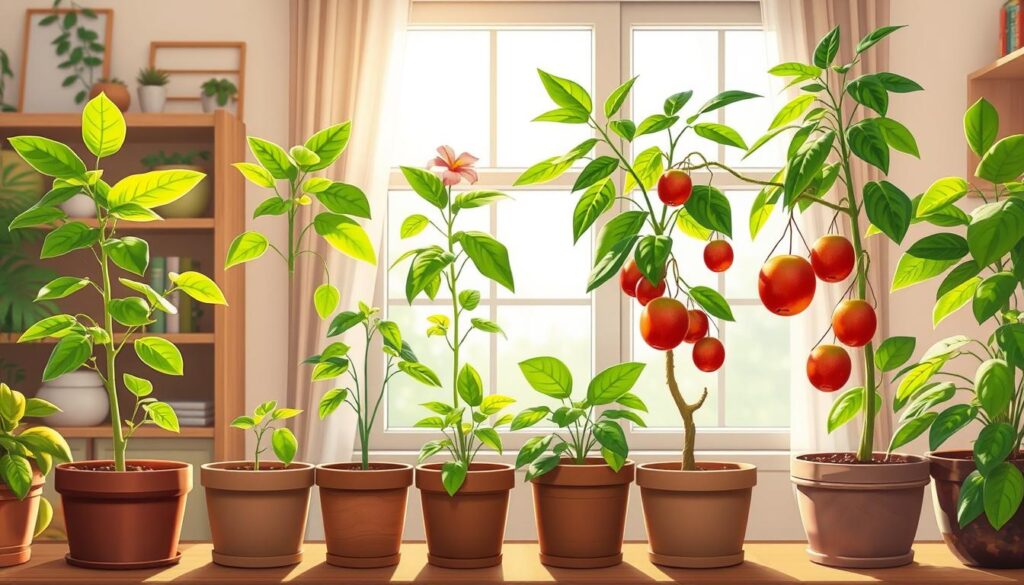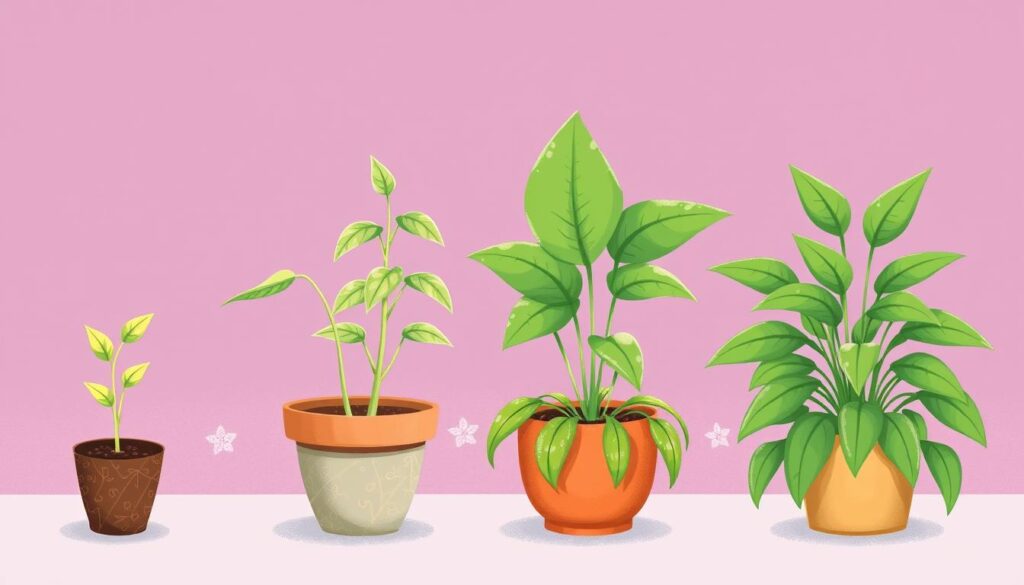Did you know nearly 40% of indoor plants don’t reach their full potential? This is because many people don’t understand the growth stages of indoor plants. In this guide, we’ll explore each stage of your plants’ life, from seed germination to flowering and fruiting. Knowing these stages helps you care for your plants better, making them thrive at home. Let’s explore the amazing journey of indoor plant growth!
Key Takeaways
- Understanding indoor plant growth stages is critical for successful plant care.
- The indoor plant life cycle includes germination, seedling, vegetative growth, flowering, and fruiting stages.
- Each growth stage requires specific care to ensure optimal development.
- Monitoring light, water, and soil quality is essential throughout the growth stages of indoor plants.
- Common problems can be identified and addressed early for healthier plants.
- Keen observation and adjustments in care can dramatically improve plant health.
Understanding the Basics of Indoor Plant Growth
For any gardener, knowing about plant growth phases is key. Each phase is a unique stage a plant goes through, from seedling to full growth. Recognizing these stages helps growers give the right care at each stage, ensuring the plant stays healthy and grows well.
What Are Growth Stages?
Growth stages are the steps a plant takes to develop. They include:
- Seed Germination
- Seedling Stage
- Vegetative Growth
- Flowering Stage
- Fruiting Stage
Each phase is crucial for a plant’s growth and health. Knowing when each phase happens lets gardeners act quickly if needed.
Importance of Growth Stages
Understanding plant growth phases is very important. Each stage affects things like how a plant takes in nutrients, how much light it needs, and how much water it requires. By knowing these stages, gardeners can care for their plants better, helping them grow strong and avoiding problems.
In short, learning about indoor plant growth makes gardening better and more successful. By meeting the needs of each growth stage, you can grow a healthier indoor garden.
Seed Germination in Indoor Plants
Understanding the germination phase is key for indoor plant success. It’s the start of a houseplant’s growth and health. The right conditions help seeds sprout, turning them into green plants.
Optimal Conditions for Germination
Creating the perfect environment is crucial for seed germination. Temperature, moisture, and light are all important. Here’s what you need:
| Condition | Optimal Range | Importance |
|---|---|---|
| Temperature | 70°F – 75°F | Encourages enzymatic activities for seed growth |
| Moisture | Evenly moist, not soggy | Promotes seed swelling and softening of the seed coat |
| Light | Indirect sunlight | Stimulates photosynthesis for healthy growth |
Common Problems During Germination
Even with the right conditions, problems can still occur. Common issues include:
- Over-watering: Leads to root rot and fungal infections.
- Insufficient light: Causes weak seedlings that fail to thrive.
- Incorrect temperatures: Can stall germination or lead to poor growth.
To avoid these problems, make sure water drains well and check the light. Quick adjustments can greatly improve your plant’s growth.
Seedling Stage: First Steps to Maturity
The seedling stage is key in a plant’s life cycle. It’s when plants start to show their full potential after they germinate. Knowing how to care for seedlings is crucial for their growth and success.
Identifying Healthy Seedlings
Healthy seedlings have certain signs that show they are growing well. Look for:
- Vibrant Green Leaves: Bright, lush leaves mean the seedlings are getting enough light and nutrients.
- Strong Stems: Sturdy stems show the seedlings are strong and can stand up straight.
- Root Development: Good roots are vital for getting nutrients. Look for healthy, white roots in the soil.
- Even Growth: Seedlings should grow evenly, without any weak or pale spots.
Essential Care Tips
To help seedlings grow well, follow these care tips:
- Watering: Keep the soil moist but not too wet. Use a spray bottle for gentle watering to avoid harming the seedlings.
- Light Exposure: Give them enough but indirect sunlight. A south-facing window is often the best for growth.
- Soil Considerations: Use a light, well-draining potting mix. It’s important for healthy root growth.
Vegetative Growth: Building a Strong Foundation
The vegetative growth stage is key for indoor plants. It’s when they grow strong leaves and roots. Good care during this time is crucial for their health and future growth.
Importance of Light for Vegetative Growth
Light is essential for photosynthesis, vital during this stage. Without enough light, plants may have weak stems and sparse leaves. Use full-spectrum LED grow lights or fluorescent lights for 12 to 16 hours a day. Adjust the light hours based on each plant’s needs.
Nutrient Requirements
Nutrients are also vital for plant growth. Each plant needs a mix of nitrogen, phosphorus, and potassium. Choose fertilizers that meet these needs to help plants grow well. Use liquid or slow-release fertilizers to avoid over-fertilizing.
| Nutrient | Function | Recommended Sources |
|---|---|---|
| Nitrogen | Promotes healthy leaf development | Fish emulsion, blood meal |
| Phosphorus | Supports strong root growth and energy transfer | Bone meal, rock phosphate |
| Potassium | Enhances overall plant health and stress resistance | Kelp meal, wood ash |
Flowering Stage: The Beauty of Indoor Plants
The flowering stage is an exciting time for indoor plants. It shows off their vibrant blooms and unique traits. Knowing when a plant is ready to flower is key for indoor gardeners. This knowledge helps manage the growth stages well.
Signs of Flowering
During the flowering stage, certain signs show that your houseplants are ready. Learning these signs can make your indoor garden even more beautiful. Key signs include:
- Bud Formation: Look for small buds on the plant; these are the first signs of flowers.
- Leaf Changes: Some plants grow new leaves before they bloom.
- Color Changes: Notice any changes in leaf or stem color, showing the plant is getting ready to bloom.
- Aroma Emission: Some plants release a nice scent as they prepare to flower, adding to their beauty.
- Increased Growth: A sudden increase in growth rate means the flowering stage is near.
Providing the right environment is crucial for successful blooming. The right lighting, humidity, and soil care all help. These practices are vital for beautiful blooms in houseplants.
Knowing the signs of flowering lets gardeners enjoy this important stage. It ensures vibrant blooms thrive indoors.
Fruiting Stage: Harvest Time for Indoor Plants
The fruiting stage is a key moment in an indoor plant’s life. It shows the plant’s hard work from earlier stages. It’s exciting for gardeners and important for a good harvest. Knowing how to care for plants during this time can greatly improve the fruit’s quality and amount.
Care During the Fruiting Stage
Right care during the fruiting stage is key for a good yield. Here are some tips to help:
- Water Management: Keep the soil moist but not too wet to prevent root rot.
- Nutrient Adjustments: Use a fertilizer high in phosphorus to help fruits grow. Check the plant’s nutrient needs as it grows.
- Light Conditions: Most fruiting plants need bright, indirect sunlight to thrive.
- Humidity Levels: Keeping humidity between 50-70% helps, especially for tropical plants. It prevents stress.
Common Fruiting Challenges
Indoor plants can grow fruit, but they face some challenges. Knowing these issues helps solve them:
- Pest Infestations: Watch for pests like aphids and spider mites, which can harm fruit quality.
- Diseases: Fungal infections can happen, especially in humid places. Good air flow helps prevent this.
- Fruit Drop: Stress from too little light or sudden temperature changes can cause fruit to drop early.

In summary, proper care during the fruiting stage is crucial. It makes the indoor plant experience richer. By tackling these key points, gardeners can overcome challenges and enjoy the fruits of their labor.
| Challenges | Prevention Strategies |
|---|---|
| Pest Infestations | Regularly check plants and use organic pest control methods. |
| Diseases | Ensure proper drainage and airflow around the plants. |
| Fruit Drop | Maintain consistent light and temperature conditions. |
Factors Affecting Plant Growth Stages
The journey of indoor plant growth is shaped by many external factors. Knowing how these elements affect houseplant growth is key to healthy plants. Environmental conditions and soil composition are the main factors.
Light, Water, and Humidity
Light, water, and humidity are crucial for indoor plants. Each one affects the health and growth of houseplants:
- Light: Plants need different light levels, from direct sun to low light. Good light helps with photosynthesis, which is vital for growth.
- Water: Watering needs change with the plant’s growth stage. Too much or too little water can stress plants and slow growth.
- Humidity: Most plants prefer higher humidity. The right humidity helps with transpiration and nutrient uptake, important for growth.
Soil Quality and Nutrients
Soil and nutrients play a big role in each growth stage of houseplants. The right soil mix is key for healthy roots and nutrient absorption:
- Soil Quality: Pick well-draining soil made for indoor plants. Bad soil can cause root rot and nutrient shortages.
- Nutrients: Fertilize regularly, especially when plants are growing and flowering. This ensures they get the nutrients they need.
Common Indoor Plants and Their Growth Stages
Learning about the growth stages of houseplants can make indoor gardening more fun. Each plant has its own needs during different stages. This section looks at popular plants for beginners and the special care exotic plants need.
Popular Choices for Beginners
Many plants are great for new gardeners. They have easy-to-follow growth stages. Here are some good options:
- Spider Plant: This plant is tough and easy to care for as it grows.
- Pothos: It does well in different light and has simple growth stages.
- Snake Plant: It grows slowly, making it perfect for beginners to learn.
Specialized Care for Exotic Plants
Exotic plants add beauty to indoor spaces but need extra care. Knowing their special needs is key:
- Fiddle Leaf Fig: It needs bright, indirect light and regular watering.
- Orchids: They need specific humidity and light, so careful monitoring is important.
- Calathea: Its colorful leaves require careful attention to moisture and humidity.

Troubleshooting Growth Stage Issues
Knowing the growth stages of indoor plants helps spot problems early. Watching your plants closely lets you catch issues before they get worse. This makes it simpler to find and use the right solutions for each growth phase.
Identifying Problems Early
Many signs show when indoor plants are struggling. Look out for:
- Yellowing leaves: This means too much water or not enough nutrients.
- Wilting: It could be from too little water or root rot.
- Pale foliage: This usually means the plant isn’t getting enough light.
- Stunted growth: This might be due to poor soil or missing nutrients.
Effective Solutions
After spotting the problems, you can start fixing them. Here are some ways to help your plants:
- Adjust watering habits: Make sure you’re not watering too much or too little.
- Improve light conditions: Move plants to get more natural light if they’re pale.
- Fertilize correctly: Use the right fertilizers to fix nutrient gaps.
- Repot if necessary: For slow growth, try a new pot or soil to help roots grow better.
Tips for Managing Plant Growth Stages Successfully
Understanding your indoor plants’ life cycle is key to their growth. Regular monitoring is a great strategy. It helps you spot changes in their growth, like needing more light or water. This is especially true as they move from seedlings to flowering plants.
Regular Monitoring
Creating a routine for checking your plants is important. Look at their soil moisture, leaf health, and growth. Each stage, from seed to fruit, has its own needs and challenges.
Keep track of your plants’ progress. This helps you see patterns and catch problems early. Early detection can make a big difference in their health.
Adjusting Care as Needed
As plants grow, their care needs change. For example, a plant might need more light when it’s growing than when it’s dormant. Being flexible with your care routine is crucial.
Adjusting things like humidity, nutrients, or watering schedules is important. This ensures your plants stay healthy and vibrant throughout their life cycle.
FAQ
What are the different indoor plant growth stages?
Indoor plants go through several stages. These include seed germination, seedling, vegetative growth, flowering, and fruiting. Each stage is important for the plant’s development.
How can I ensure my indoor plants grow healthily during each phase?
To keep your plants healthy, know what they need at each stage. Give them the right light, water, soil, and nutrients. This will help them grow well.
What signs indicate that my plant is moving to the flowering stage?
Look for new buds, changes in leaf color, or a strong smell. These signs mean your plant is getting ready to flower.
How should I care for my houseplants during the vegetative growth stage?
In the vegetative stage, make sure they get enough light and the right amount of water. Also, give them the right nutrients. This will help them grow strong.
What common problems can arise during the germination stage?
Problems like too much water, not enough light, and temperature changes can happen. Keep an eye on these to help your seeds germinate well.
How can I troubleshoot issues during the fruiting stage?
Spot problems like pests, diseases, or nutrient issues early. Fix these quickly, adjust watering, and give the right nutrients. This will help your plant fruit well.
What factors significantly affect the growth stages of houseplants?
Light, water, humidity, and soil quality are key. Managing these well will help your plants grow healthy and strong.
How often should I monitor my indoor plants for growth stage changes?
Check your plants every week. Look for signs of growth or problems. Adjust their care as needed to meet their changing needs.


